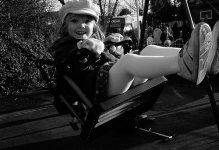wintoid
Back to film
So it's the beginning of a new year, and last night was my last bit of free time before a hard (?) day at work today. I decided to clear out the one half-finished roll of film from my Olympus 35SP. A nice roll of Neopan 400, up to about frame 16 or so. I decided to try Rodinal, because I'm casually looking for a developer that works well (for me) with this film.
2 minutes in to development, I suddenly found myself wondering whether I rated the film at 400. Checked the camera, and nope I rated it at 800. Eek! So rushed upstairs to the computer to get a time for Neopan 400 @ 800 in Rodinal, in between agitations of the film. No dice. I couldn't find the time anywhere (and still can't).
In the end I took a guess, extending the 11 minutes I was expecting to use for ISO400 to 16 minutes for ISO800. I did get results, albeit rather dark, and have attached one to this post as illustration.
I now find myself wondering about a good starting time for Neopan400@800 in Rodinal 1:50. Does anyone have a time?
2 minutes in to development, I suddenly found myself wondering whether I rated the film at 400. Checked the camera, and nope I rated it at 800. Eek! So rushed upstairs to the computer to get a time for Neopan 400 @ 800 in Rodinal, in between agitations of the film. No dice. I couldn't find the time anywhere (and still can't).
In the end I took a guess, extending the 11 minutes I was expecting to use for ISO400 to 16 minutes for ISO800. I did get results, albeit rather dark, and have attached one to this post as illustration.
I now find myself wondering about a good starting time for Neopan400@800 in Rodinal 1:50. Does anyone have a time?



